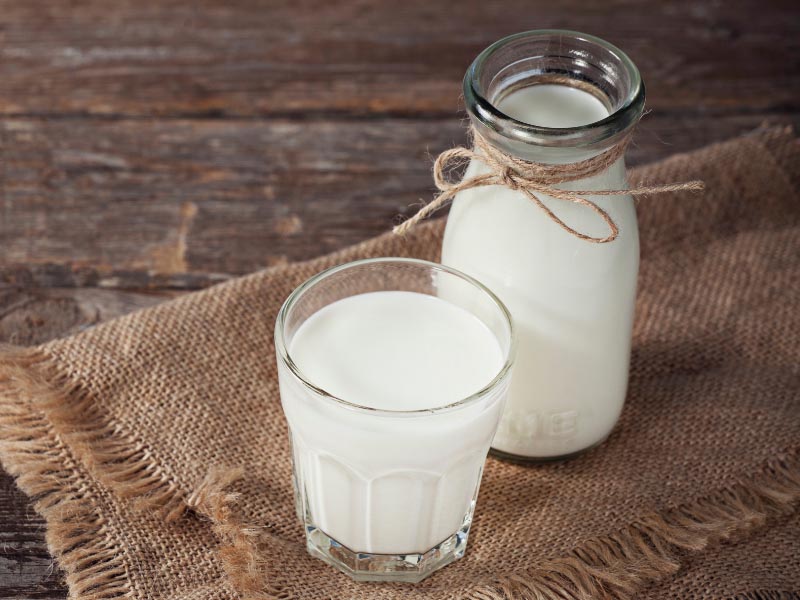Do you drink milk every day or have it along with your breakfast cereal? So, how much do you know about this white liquid that is a part of your staple diet? Apart from the fact that it comes from animals, we really don’t know much about the history, types of milk and their unique characteristics. This is why we have put together all this information for you in the article to make you appreciate every drop of this nutritious liquid food more than ever before!
What is Milk and its History?
Milk, as we know, comes from the mammary glands of domesticated animals like goats, cows, buffaloes etc. It is a white liquid that is rich in nine types of amino acids, protein, calcium, vitamin D, Vitamin B12 and other key nutrients. This incredible nutritional profile makes Milk one of the healthiest foods on the planet, particularly good for bones and teeth.
Coming to its history, experts suggest that the practice of domesticating animals began as early as 10000 BC, when the Agricultural Revolution actually began. The demand for different types of food made humans get into animal farming primarily for milk, meat and other by-products. Originally reserved only for the wealthy class, milk slowly earned the place of staple food in every household.
Gradually, different varieties of milk got introduced into the market, which is sourced from other animals like Camels, Donkeys etc., and plants like nut milk (also called Vegan milk).
What are the Different Types of Milk and Their Characteristics?
Milk is derived from two main sources – Animals (Dairy Milk) and Plants (Non-Dairy Milk)
Depending on the type of animal or plant from where the milk is sourced, the fat content, flavour profile and health benefits vary. Most of the Milk derived from these two sources is sent to the factory, where it is processed into different varieties like skim, powder etc., to meet specific dietary requirements and culinary purposes.
See More: Different Types of Coffee Drinks
Today, we shall look into the list of different types of milk and their health benefits:
Types of Milk from Animals (Dairy Milk):
1. Raw Milk:
Raw milk is an unpasteurized liquid obtained from an animal. One cup of raw cow milk contains about 8% fat and 8gms of Protein content. This milk is known to offer better health benefits than other kinds of milk due to no loss of nutrients. However, medical experts opine that drinking unpasteurized milk is a process in which milk is heated to kill pathogens) can increase the risk of infections and allergies in humans.
2. Whole Milk:
Whole Milk or Regular Milk is pasteurized and homogenized form of milk that is retained in the same form obtained from the animal. This milk is rich in taste and has a thick, creamy texture. Although many people consider whole milk as full-fat milk, the fact is that it consists of only 3.5% of fat content.
However, this variety of milk is high in calories, with an 8-ounce glass of milk offering around 150 calories. Also, the number of proteins, calcium and Vitamins are on the higher side in whole milk compared to other types of milk.
3. Skim Milk (Fat-Free Milk):
Skim Milk is obtained by removing all the fat content from whole milk. A glass of skim milk contains about 0.1% of fat, which is a negligible amount. The idea behind developing this fat-free milk was to reduce the overall calorie count. Lesser milk fat may be beneficial to heart health and a lowered risk of cardiovascular diseases. However, nutrition-wise, skim milk is quite low in important vitamins and minerals which are good for the body.
4. Lowfat Milk:
Lowfat milk is considered to be a boon for those who aspire to cut down fat in their diet. As the name suggests, low-fat milk has only 1% of fat content. The excess fat is removed using the process of centrifugation, and the leftover liquid looks watery and pale white. Weight watchers and calorie-conscious people prefer this milk due to the reduced fat amount.
5. 2% Milk:
2% Milk, as the name suggests, has an overall fat content of 2%. It is also called reduced-fat milk, which is neither too thick nor creamy like whole milk or too runny and flavourless like skim milk. 2% milk undergoes a fat-removal process, after which the desired fat content is added back to the whey (the remaining liquid). This type of milk is known to offer a good amount of vitamins and minerals with the added benefit of reduced fat.
6. Cow Milk:
Cow milk is nutrient-rich milk produced by many breeds of cows. It is one of the most consumed types of milk in the world, which contains high-quality protein, calcium and vitamins. Cow milk also contains 3-4 % fat per glass. However, the high amounts of lactose present in this milk pose a threat to those who have lactose intolerance.
7. Goat Milk:
Goat milk is sourced from domesticated goats and is highly nutritious. This milk contains good amounts of calcium, phosphorous, iodine, Vitamin B5, etc., to support a healthy body. It contains 6% of total fat per 100gms of servings. Goat milk also contains slightly lower amounts of lactose compared to cow milk, which makes it ideal for people with milk allergies.
8. Buffalo Milk:
Buffalo milk is tasty and creamy milk obtained from buffaloes. It has about 7-8% of fat content as opposed to 3-4% fat of cow milk. However, it is rich in Calcium, magnesium, phosphorous, iodine and Vitamin A, which lends a pearly white color to the milk. Buffalo milk is versatile and used for preparing many food products like cheese, desserts, ghee, paneer etc., which are widely used in different cuisines.
9. Lactose-Free Milk:
Lactose is a type of sugar that is found in most dairy-based milk. However, a fair percentage of the world’s population suffers from a lack of enzymes that can digest lactose. This is why lactose-free milk is introduced in the market, which contains zero lactose. It is obtained by adding lactase to regular cow milk, which helps in breaking down the lactose. This type of milk has no major difference from normal milk in terms of taste, flavour, texture or consistency.
10. Evaporated Milk:
Evaporated milk is a dairy product which is made to increase the shelf-life of normal cow or buffalo milk. It is prepared by evaporating 60% of the water from fresh milk to obtain thick, unsweetened milk. Because of the creamy consistency, this milk is used for making desserts and toppings. To use it as regular milk, you can simply add the desired amount of water.
11. Sweet Condensed Milk:
Sweet condensed milk is the same as evaporated milk, with 60% of water lost in the evaporation process. However, the difference is that condensed milk has added sugar which makes it a delicious treat. Although not a healthy milk option, sweet condensed milk is widely used in preparing different types of desserts, sweetmeats and toppings.
See More: Types of Ice Creams in India
12. Buttermilk:
Buttermilk is not exactly milk with loads of butter as people think about it. It is prepared by adding cultures to milk, due to which it gets a slightly tangy and acidic taste. The traditional process of preparing buttermilk in countries like India is to churn curd or yoghurt (a solidified form of cultured milk) with some water and separate the cream. The result is a watery liquid that is considered to be very good for our gut health.
13. Flavoured Milk:
Flavored milk is a popular dairy-based beverage prepared by adding flavours, colors and sugar to milk. The product is marketed commercially in the form of bottled or tetra pack drinks. Many people, particularly kids, enjoy having flavored milk as an evening snack or for a quick refreshment. Although it has the same nutritional profile as regular milk, the added sugar and artificial agents may not be beneficial to our health in the long run.
Types of Milk from Plants (Non-Dairy Milk):
14. Almond Milk:
Almond milk is one of the most widely consumed plant-based milk in the world. It is extracted from soaked almonds and has a sweet and nutty taste. This vegan milk offers only 39 calories per serving, making it ideal for weight watchers. It is low in fat content and high in Vitamin E. Commercially sold Almond milk is fortified with Vitamin D and Calcium to support healthy bones. Homemade almond milk might taste better but lacks these two essential nutrients.
15. Oat Milk:
Another widely consumed plant-based milk is Oat milk. It is extracted from a mixture of oat grains and water and has a creamy texture with a typical oats taste. In order to meet the nutritional requirements, commercially sold oat milk is fortified with calcium, vitamin A, D, B1 and B2. This variety of milk is a great choice for making vegan smoothies and beverages, as oat milk can blend well with almost any type of flavour- be it fruit or chocolate.
16. Soy Milk:
Soy Milk occupies a fair share of the vegan milk market in the world. It is prepared by soaking the soybeans, grinding them and boiling the mixture to filter out the liquid. This bean-based beverage has its origins in China, where it is consumed as a by-product of Tofu. One cup of Soy milk offers 80 calories with about 4 gms of fat and 7gm of protein. Branded soy milk is fortified with vitamins and minerals to increase its nutritional value.
17. Cashew Milk:
Cashew milk is another nut-based milk which is prepared from soaked Cashews. Unlike almond milk, cashew milk is quite creamy and rich in taste. This is why many Vegans prefer this milk over other plant-based milk to prepare sweets and desserts. Homemade cashew milk offers 160 calories per serving and a high amount of fibre content due to less liquid straining. Storebought one undergoes a lot of filtration process and is fortified with additional vitamins and minerals.
18. Coconut Milk:
Coconut milk is a tasty white opaque liquid extracted from the pulp of matured coconuts. This rich taste is acquired due to the high amounts of saturated fat content. There are three types of coconut milk – thick, thin and skim. Thick coconut milk is high in fat and calorie-dense (15-20% fat), while thin coconut milk has a maximum of 10% fat and skim coconut milk has only 1% fat content.
Coconut milk is widely used in preparing traditional dishes like curries and gravies, while processed ones are used as substitutes for regular milk.
19. Rice Milk:
Rice milk is prepared by pounding the rice grains, blending it with water and filtering out the liquid. It has a watery consistency and an earthy flavour. Rice milk is high in carbohydrates but is extremely low in vitamins and minerals. This is why commercially sold rice milk is fortified with calcium, vitamin B12, B13 and iron. It is slowly gaining popularity among vegans due to its low-allergen profile.
See More: Cow Breeds and Varieties in India
20. Hemp Milk:
Hemp milk may not be as commercially popular as other plant-based milk, but it is definitely earning a good reputation for its health benefits. This type of milk is prepared by crushing soaked hemp seeds and filtering out the liquid. Although Hemp is notorious for its mind-altering effects, Hemp milk is free from such effects and safe for regular consumption. This nutty and earthy flavoured milk offers 83 calories per serving.
Those are some of the different types of milk available in the current market. Remember that each of these milk varieties comes with its own set of pros and cons. It is important to understand your dietary requirements and preferences before deciding which one is the best!
FAQs:
Q1. What Is Homogenized Milk?
Ans: Homogenization is a process in which the milk is forced through small openings under high pressure to distribute the fat globules evenly. This is why Homogenized milk has a consistent and creamy texture compared to unhomogenized milk.
Q2. What Is Half and Half Milk?
Ans: Half and Half milk is a popular type of milk in countries like the United Kingdom and the United States. It comprises of one-half cream and one half whole milk to attain thick consistency. The fat content of this milk can range anywhere between 10.5% to 18%.
Q3. Is It Ok To Drink Raw Milk?
Ans: Raw milk does not undergo a process can pasteurization in which the milk is heated to kill dangerous pathogens. Drinking raw milk can increase the risk of dangerous infections and allergies from different types of bacteria in it. So, it is better to avoid drinking milk that is raw and unpasteurized.
Disclaimer:
The information provided in the article is purely for informational purposes and must not be treated as an alternative to professional medical advice. Please go through the list of possible allergies and side effects of every type of milk before consuming it internally.












































